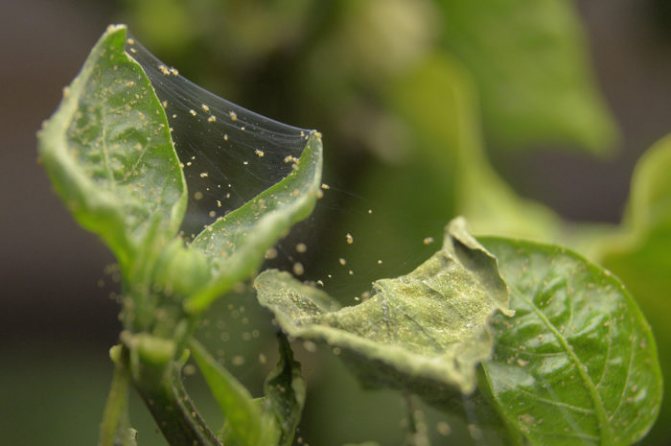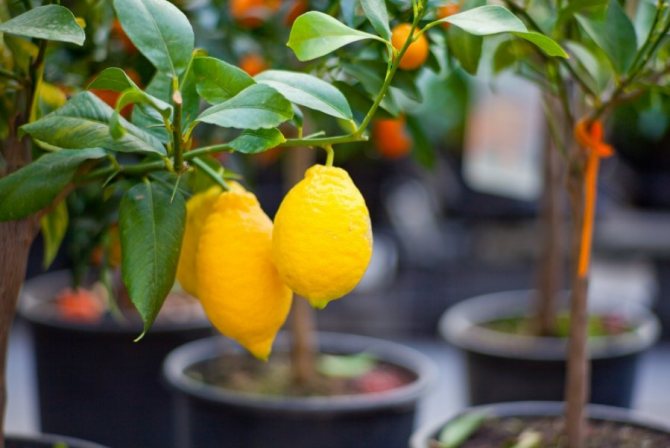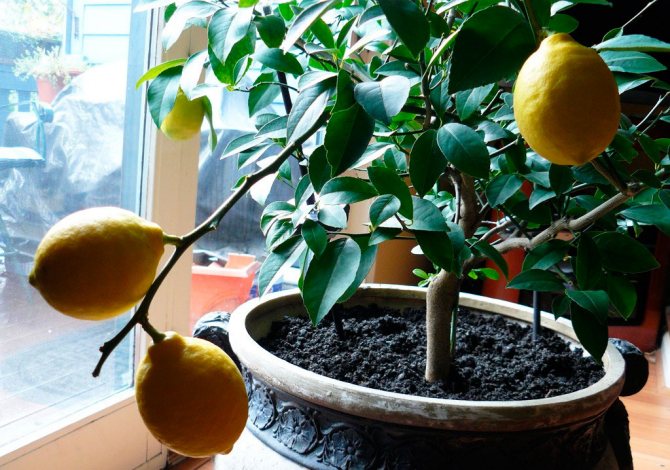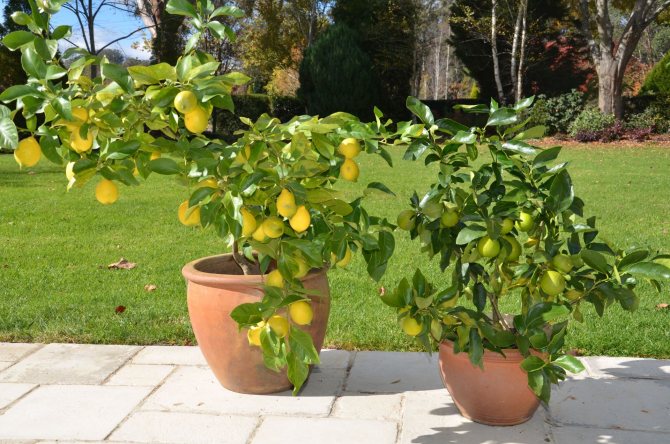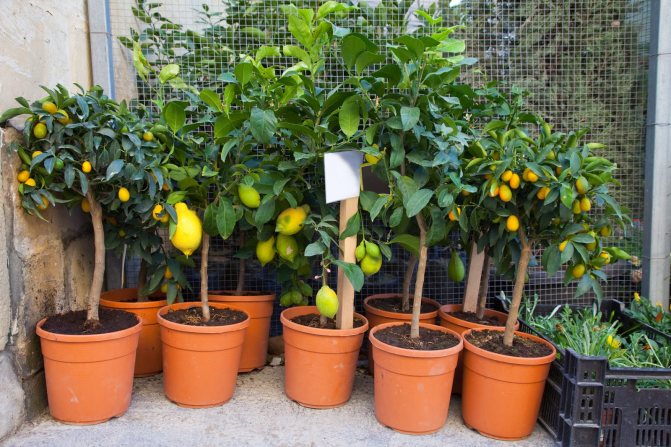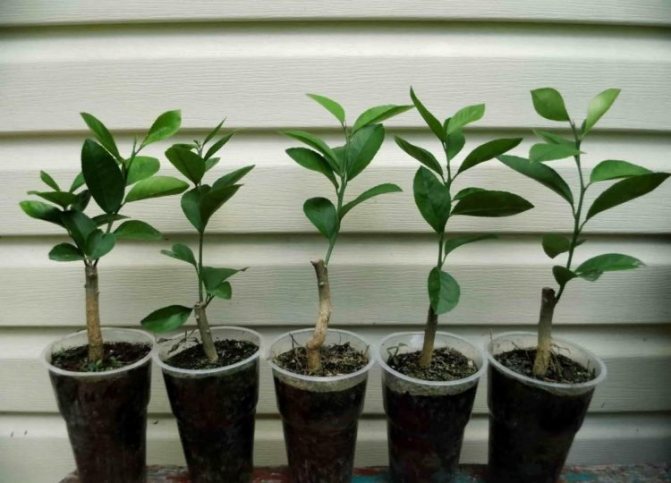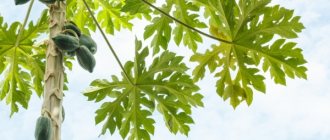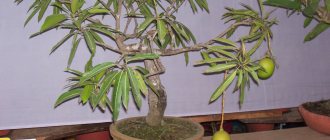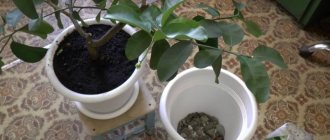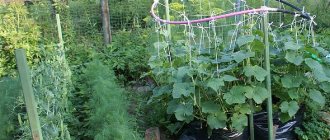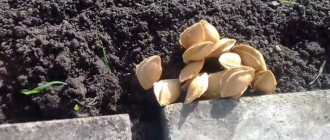An exotic lemon tree with aromatic and healthy fruits is grown not only in warm countries. Many flower growers have mastered the technique of growing lemon and now they proudly show the plant along with the usual violets or geraniums. The beauty of the citrus tree is that it turns beautifully green even at home, but it does not always bear fruit. How to grow lemon with fruits? Let's talk about the secrets of planting, feeding and protecting a plant in a home or an ordinary city apartment.
Homemade lemon description
Countries where lemons grow have a tropical and subtropical climate. There, trees up to 8 meters high with large juicy fruits grow in open ground. The largest fruits are varietal.
The largest lemon, which was registered in the Guinness Book of Records, weighed 5265 g, and the fruit did not grow anywhere, but in the house of an ordinary Israeli Aharon Shemoel.
The record-breaking lemon tree is, of course, an exception to the rule. Houseplants are more modest in size. Their height rarely reaches 2 m, usually limited to 1.5 m, but the crown of the tree is spreading, the leaves are dense, glossy, leathery, of a pleasant green color. After three years, the leaves crumble, and new ones gradually grow in their place.
Lemon leaves are miniature stores of valuable aromatic essential oil, thanks to which the fruits cannot be confused with any other fruit in the world. In addition to the wonderful aroma, they have disinfecting properties, that is, the lemon tree can be safely grown by anyone who cares about their health.
A real gift is the flowering period of the tree. Beautiful flowers, white on the outside and slightly pinkish on the inside, exude a delicate aroma and delight the owner of the plant. Later, the fruits are tied. They are slightly smaller than varietal lemons grown on the ground. However, absolutely all valuable substances are completely preserved in them.
Used parts and active substances of lemon tree
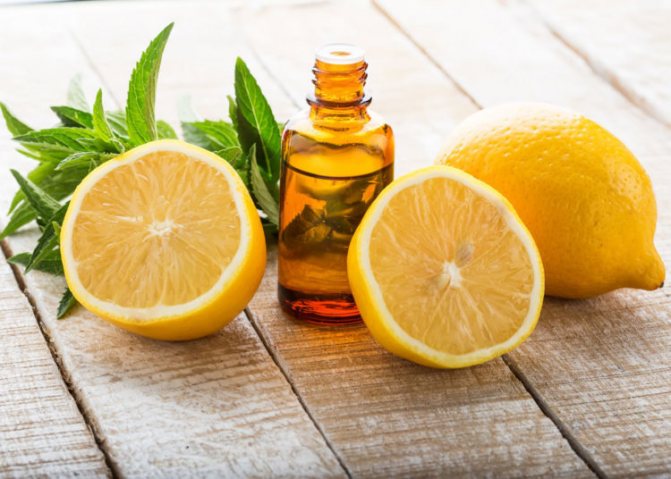
- In folk medicine, the fruits and leaves of the lemon tree are widely used for treatment. For the preparation of medicinal products in herbal medicine, either whole fruits are used, or only seeds or zest.
- Essential oil in aromatherapy is obtained by squeezing from the peel or distilling from the leaves. Leaves and fruit are harvested in winter. Modern agricultural methods in some countries allow you to get a summer harvest, but the lemon tree is greatly depleted.
- The fruit of the lemon tree, as noted above, is very rich in vitamin C. They also contain many active substances in the form of coumarins, flavonoids and carotenoids, which give the fruit a peculiar yellow color.
- The leaves are also rich in flavonoids. The essential oil extracted from the leaves and rind of the fruit is rich in sequi and monoterpenes, including limonene (up to 80%), as well as citrals, which give the fruit a characteristic odor.
- Traditional medicine recommends regular consumption of lemon juice in case of fragility of capillary and venous vessels, arteriosclerosis. And also for the prevention of colds: pharyngitis, tonsillitis, flu, runny nose, in case of digestive disorders. Due to its anti-inflammatory properties, lemon is used as a complementary remedy in combination with other medicines to treat rheumatism and gout.
- Lemon contains aldehydes (citrals), which can irritate the skin and mucous membranes, and coumarins sometimes cause photosensitization.
Video
How to grow lemon at home
At home, lemon is grown on a windowsill or on the floor in a large tub. You can plant a lemon at home in a small flower pot and, with good care, it will bear fruit all year round, yielding up to 30 small tasty fruits. On average, up to 150 citrus fruits are removed from one "apartment" tree, and they are not inferior to their large southern counterparts in taste. It is interesting that it is possible to grow a large domestic tree even from a stone, or propagate it by cuttings.
A prerequisite for home growing is a spacious room, where a lot of light comes in. The tree is quite capricious to soils, it is attacked by diseases and pests.
It should be borne in mind: from the moment of planting to the first fruits, it often takes more than one or even two years. In general, the waiting period is 5 years.
However, if you have passed the test with honor, provided the lemon with good home conditions, the tree will delight you for several years in a row. Over the years, the yield of homemade lemons only increases.
Growing lemon from seed
Growing homemade lemon from the seed is real. Any ripe fruit contains a few seeds ready for propagation. In order for the seeds of the tree to germinate, it is important to get them out of the citrus and plant them. The distance between the seeds should be 5-7 cm.
Seeds like the soil drained with peat content. Ordinary soil for home flowers, which is sold in any flower shop, is suitable.
During the germination stage, it is important to ensure that the soil remains moist, but not overly wet. Pouring over the lemon tree is not worth it, otherwise the seeds will simply rot.
After about two weeks, the first sprout will appear - tender and weak. Now it is important to cover it with a jar, put it in a bright place where direct sunlight does not fall. From time to time - 2 times a day - you need to remove the jar and let the sprouts breathe, be saturated with oxygen, and then hide it again under a glass jar.
Landing
When buying a lemon tree, inspect the top and bottom of the leaves for insects or red spiders. Shorten branches that are too long at the level of the young shoot to maintain their shape. Transplant the lemon tree into a larger pot than the one you purchased at the time of purchase, but only a few centimeters (in a large pot, the lemon may not bloom).
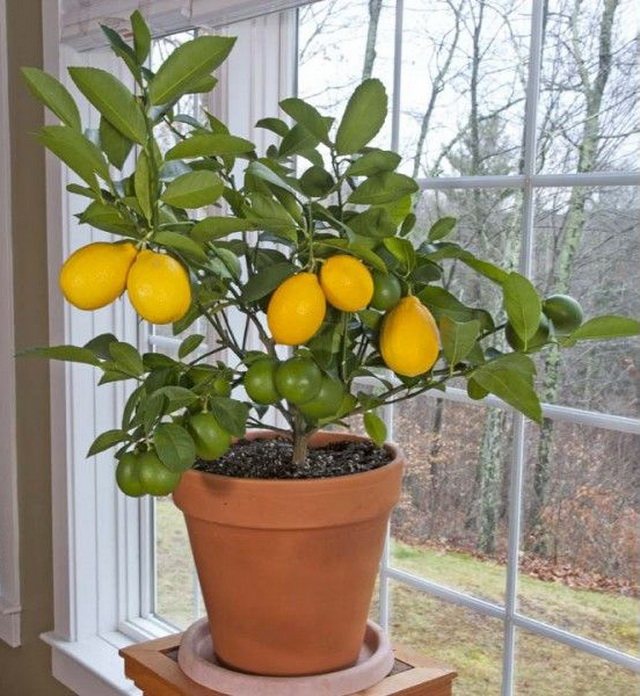

Lemon tree on the windowsill. Illustrations are taken from open sources.
On a note! Do not forget the drainage hole, put a good drainage layer on the bottom of the pot so that the roots of the plant are not in the water, and then concrete soil.
Pre-dip the plant with the lump in a bowl of water. In April - May, soil or organic fertilizers are added to the surface of the pot. Ideally, it is recommended to use a removable drip tray so that you can also refresh the earthy mix on the sides.
Lemon care at home
Lemon grows actively at home, if the amateur gardener is not lazy to take care of the home plant, provides him with all the conditions, makes sure that the tree is light, humid, spacious.
A prerequisite is to pinch and cut trees for a good harvest of lemons, feed them in a timely manner, and maintain a water temperature that is comfortable for a lemon during watering.
Despite the fact that there are many rules, they do not take long. With a little effort, patience, and the lemon tree will definitely bloom and start bearing fruit.
Lemon primer
The land for lemon, as we have already said, must necessarily contain peat. In addition, it is important to saturate it with sand, humus, and provide good drainage. The lemon tree is very fond of phosphorus, loose, slightly acidic and neutral substrates.
Before planting a cuttings or sprouted seeds, it is a good idea to sift the soil through a large sieve or sieve with large meshes. It's not bad - to ignite it in the stove, oven in order to kill pathogenic bacteria.
It is also good to spill soil with a weak manganese solution. If it is difficult to select the ratio on your own, you should entrust the choice to specialists: purchase land in a proven nursery or horticultural center.
Temperature and lighting for lemon
Lemon trees grow in warm countries, and it is important to create conditions at home that are as close to natural as possible. Citruses like light rooms where there is a lot of air.
The best option is to put the tree on the south side of the dwelling. Small houseplants under a can-dome, and "fledged" plants - without it. The optimum temperature is 21-24 degrees. Moreover, the plant will grow more evenly, the crown will grow beautifully if you periodically turn the tub or pot, exposing the house tree to different sides to the light.
But direct sunlight is harmful to the tree - it is important to avoid them by protecting the windows with blinds or a screen.
It is good for residents of country houses to periodically take the tub out into the open air. Homemade lemons just love to be ventilated, nourished with warmth and sunlight. Again, so that they do not burn out, a pot or tub is placed under the crown of a large tree.
In nature, autumn always comes after the summer, so the lemon tree is waiting for the change of seasons. Starting from November until March, it is worth moving it to a cooler room with temperatures down to -10 degrees.
Watering lemon and humidity
The root system of lemon trees deteriorates in wet soil and dries up too dry. Therefore, a florist should know: how often to water the lemon, and to what state to moisten the soil.


- First, it makes sense to start with water preparation. It should be slightly warm, clean, and settled. You can take rainwater or, for example, thawed water.
- Watering is carried out as soon as the soil has dried up a little, but has not become solid - the lemon does not like this. The tree loves humidity in the region of 70%, it is easy to follow this if you purchase a device.
- Many growers practice growing lemon trees on a pallet with expanded clay. The material wonderfully absorbs water, gradually gives it to the environment, which creates the most comfortable microclimate for a home tree.
In summer, citrus is sprayed with water - the leaves become strong, glossy, elastic to the touch.
Top dressing lemon
Fertilizer for lemon is best purchased ready-made and used 1-2 times a month. Good reviews from the composition "Ideal", "Zdraven" - Russian dressings are democratic. If your store does not have such, look at the composition: it should contain manganese, boron, zinc.
Fertilizer
Caring for varietal lemon at home includes regular feeding, because it receives food only from water and a limited amount of soil. For normal growth and development, it needs many elements - nitrogen is necessary for growth, potassium and phosphorus help to set, ripen fruits, ripen wood, calcium, magnesium, manganese, fluorine, iron, other elements are necessary for full vegetation. Therefore, the older and larger the plant, the more often it is fed.
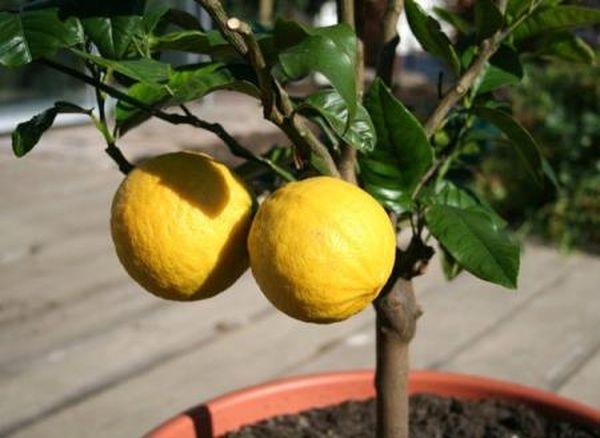

Top dressing is usually carried out root at the same time as watering, but if necessary, the leaves absorb well the elements they need from foliar dressing (spraying).
Of organic fertilizers, lemon responds well to watering with an infusion of ash, a solution of an infusion of manure (especially horse manure), only it needs to be very strongly (tenfold) diluted. Some growers use herbal infusions - quinoa, birch. Pour the crushed grass with water, insist for five days, then filter the infusion, add the same amount of water, water it a few hours after the main watering.
Of the mineral fertilizers, superphosphate is usually recommended, 50 g of the substance is dissolved with 1 liter of water, but before use it is better to dilute with the same amount of water. Ammonium nitrate is used according to the same scheme, only 30 g of the substance is taken.
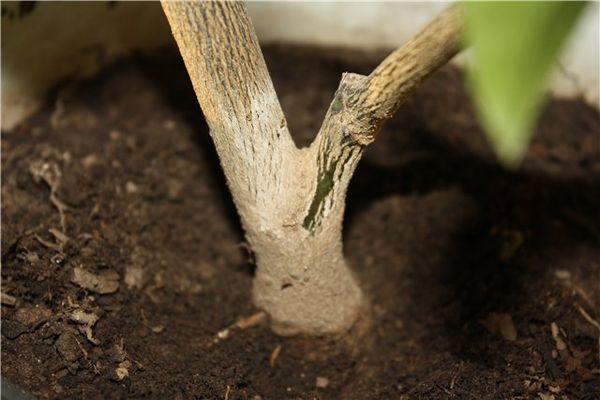

Specialized stores offer ready-made mixtures for fertilizing citrus fruits, you can use them, dilute according to the instructions, but then add more water, that is, reduce the concentration, because all these fertilizers are designed for the maximum size of an adult plant.
Young plants are rarely fed - after a month and a half, and adults can be fed every 10-15 days, it all depends on the state of the tree, its growth rate. The appearance will tell you if additional feeding is needed. If you overfeed the plant, then the situation will be difficult to correct, it is better to wait a little, make sure that fertilizers are needed.
Diseases and pests of lemon home causes and treatment
Lemon diseases are usually terrible for those plants that the owner does not care enough for. It can be yellow spots or shiny drops, leaves suddenly falling off. Finally, the tree may protest and simply refuse to flower and bear fruit. How to recognize diseases and pests? How to help decorative lemon?
Leaves turn yellow
When the leaves of homemade lemon turn yellow, the florists immediately conclude that it lacks iron and buy fertilizer to feed the plant with this valuable trace element. A very effective fertilizer for lemon, and for all homemade citrus fruits, is a product of Russian agronomists called Fasco.
Lemon sheds leaves
If the lemon suddenly begins to shed its leaves, this is a sure sign of stress that the plant is going through. Think: why did this happen? Perhaps you drastically changed his place of permanent residence, put him under the scorching rays of the sun? It is worth looking at the home conditions of the tree: arrange artificial lighting in winter, feed, follow the ground so that it does not dry out. Lemons dislike both sour and dry soil alike.
Lemon dries
If a lemon has dry leaves around the edges, it may well be lacking in certain nutrients, such as phosphorus in the soil itself.
Then it is worth unscheduled feeding the home plant with high-quality balanced fertilizers. You can choose ready-made fertilizers, although a proven and favorite "delicacy" of lemons is ordinary ash.
The tree is not fed often - once or twice a month, but if signs of the disease appear, you can slightly increase the amount of dressings by about 2 times more.
Why lemon does not bloom and bear fruit
Homemade lemon refuses to bloom and bear fruit only in one case - it lacks the strength for active growth, development, and even more so, bearing fruit. That is why the buds that have tied up, with all the desire to see them, are cut off from the tree in the first year of life.
In general, a lemon tree grown from seeds does not yield earlier than 8 years after planting. But grown by cuttings bears fruit after 3 years.
Homemade citrus, which was grown by the split grafting method, pleases with lemons in just one year.
One of the proven methods of accelerating the fruiting of a tree is constriction. For this, the branches are tied from the bottom with rigid wire rings. The procedure, although it seems harsh, perfectly stimulates the appearance of the first flowers.
Pests
Even a domestic tree is not immune to pest attacks.
- One of the enemies of homemade lemon is hairy lice or mealy worms. They love dry weather and are terrified of wet weather. The risk of worms will be minimized if you wipe the tree leaves from time to time with a damp, soft cloth.
- Another attack is the shield. It looks like shiny bead drops, sticky to the touch. Homemade lemon is treated for scabbard with a weak soapy solution - only 2 tbsp is put in one liter of clean water.l. soap, carefully dissolving it in the container. The leaves of the tree are wiped with soapy water, and then washed with running water (you can take a shower). At the end, be sure to wipe the leaves dry.
- Small dots of a light shade indicate the presence of a spider mite and lemon leaves rolled into a tube. The tree is treated with sulfur, which is sold in garden centers of the desired concentration.
To summarize, growing an ornamental lemon tree at home is troublesome but rewarding. With good care, attentive attitude, the tree will delight up to 40 years and longer. Will give health, joy, clean air filled with tropical aromas.
And, of course, the main reward is fragrant homemade lemons grown by our own hands. Although, before planting a lemon, it is worth weighing the pros and cons and assessing your strengths.
Transfer
The tree is grown only in a properly selected pot, so as it grows, transplanting into a larger container is required.
Attention! Too large a pot will cause root rot.
The container size increases gradually, for which the growth of roots is taken into account. The transplant is carried out in a standard way, for which an earthen lump is pulled out of the pot, transferred to a prepared container. After that, the citrus culture is exhibited in its original place. A change of environment negatively affects development.



